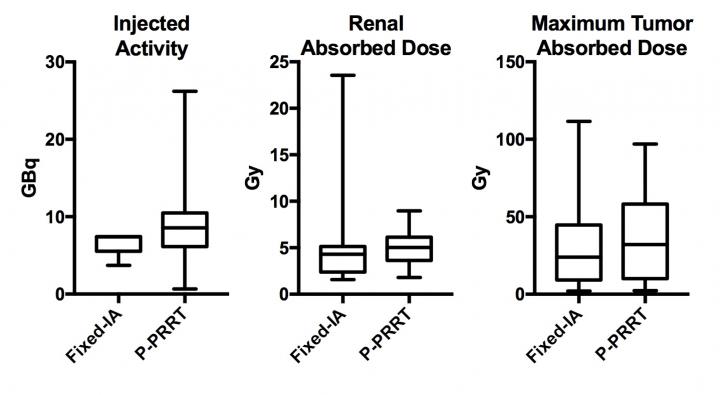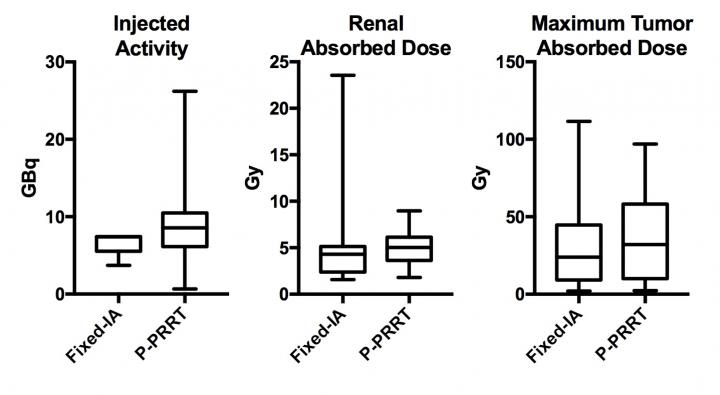
Credit: Michela Del Prete and colleagues, CHU de Québec – Université Laval
Denver, Colo. – Neuroendocrine cancer is exceedingly difficult to manage and unlikely to be cured, but researchers intend to slow progression of these tumors and aid survival by personalizing patient dose of peptide-receptor radionuclide therapy (PRRT), according to research presented at the 2017 Annual Meeting of the Society of Nuclear Medicine and Molecular Imaging (SNMMI).
PRRT has become a treatment of choice for relatively rare and easy-to-overlook neuroendocrine tumors (NETs). The targeted treatment is designed to home in on and attach to peptide-receptor positive tumors, while sparing tissues that might otherwise be damaged by systemic treatments. However, researchers are still perfecting the practice.
"So far, the majority of PRRT treatments have been administered one-size-fits-all, meaning every patient receives about the same amount of radioactivity," said Jean-Mathieu Beauregard, MD, assistant professor in the Department of Radiology and Nuclear Medicine at Université Laval in Quebec City, Quebec, Canada. "This results in highly variable absorbed radiation doses to organs and tumors. Many patients may not draw the maximum benefits from PRRT because they end up receiving a lesser dose than their body can realistically tolerate."
For this study, researchers used a PRRT called lutetium-177 (177Lu)-octreotate, which mimics the somatostatin growth-inhibiting hormone. Ordinarily, patients receive a fixed amount of radioactivity, such as 200 millicuries, in several sequential cycles. This marks the first time that 177Lu-octreotate PRRT has been matched to the patient's individual tolerance based on finely tuned SPECT dosimetry that evaluates how much radiation is building up in key organs like the kidneys.
A total of 27 neuroendocrine cancer patients underwent 55 personalized 177Lu-octreotate cycles from April to December 2016, followed by quantitative SPECT dosimetry. Radiation dose was quantified for the kidneys to optimize the administered amount of radioactivity, while remaining safe and well tolerated by patients. Side effects were recorded and blood counts, as well as renal and hepatic biochemistry, were performed at two, four and six weeks after each cycle of treatment. Results showed an increase in the radiation dose to tumors for a majority of participants–increases as high as three times the dose delivered with conventional PRRT. Furthermore, serious side effects and toxicity remained infrequent with the personalized approach.
Additional research is planned for the coming months to determine how personalized PRRT results in improved therapeutic benefits, such as reduced tumor progression and longer survival.
###
Scientific Paper 242: "Personalized 177Lu octreotate peptide receptor radionuclide therapy of neuroendocrine tumors: initial dosimetry and safety results of the P-PRRT trial," Michela Del Prete, François-Alexandre Alexandre Buteau, Alexis Beaulieu, Jean-Mathieu Beauregard, Department of Radiology and Nuclear Medicine and Cancer Research Center, Université Laval; Division of Nuclear Medicine, Department of Medical Imaging, CHU de Québec – Université Laval; Oncology Branch, CHU de Québec – Université Laval Research Center, Quebec City, Quebec, Canada, SNMMI's 64th Annual Meeting, June 10-14, 2017, Denver, Colo.
Link to Abstract
Please visit the SNMMI Media Center for more information about molecular imaging and personalized medicine. To schedule an interview with the researchers, please contact Laurie Callahan at (703) 652-6773 or [email protected]. Current and past issues of he Journal of Nuclear Medicine can be found online at http://jnm.snmjournals.org.
About the Society of Nuclear Medicine and Molecular Imaging
The Society of Nuclear Medicine and Molecular Imaging (SNMMI) is an international scientific and medical organization dedicated to raising public awareness about nuclear medicine and molecular imaging, a vital element of today's medical practice that adds an additional dimension to diagnosis, changing the way common and devastating diseases are understood and treated and helping provide patients with the best health care possible.
SNMMI's more than 17,000 members set the standard for molecular imaging and nuclear medicine practice by creating guidelines, sharing information through journals and meetings and leading advocacy on key issues that affect molecular imaging and therapy research and practice. For more information, visit http://www.snmmi.org.
Media Contact
Laurie Callahan
[email protected]
@SNM_MI
http://www.snm.org
Original Source
http://www.snmmi.org/NewsPublications/NewsDetail.aspx?ItemNumber=24292
############
Story Source: Materials provided by Scienmag





